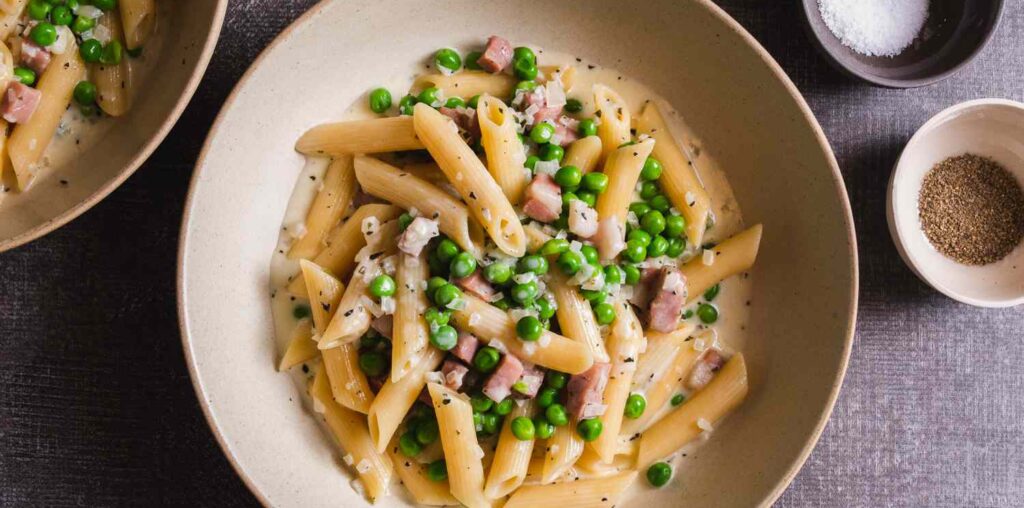Why It Works
- Prosciutto cotto is more mild and delicate in flavor than prosciutto crudo, so you can pack in thick cubes of the ham without making the dish overly salty.
- Reduced cream and starchy pasta cooking water form a velvety sauce without any need for making a roux.
- Adding frozen peas at the very end of the cooking process, off-heat, ensures they get warmed through rather than overcooked.
I went to culinary school in Emilia-Romagna, and after a long day at La Scuola Internazionale di Cucina Italiana trying to digest lessons about pasta-rolling, wine-identifying, and cheese-tasting taught in another language, the last thing I wanted to do was go grocery shopping and make myself dinner.
Luckily, the pantry staples of Parma are pretty delicious. Your fridge is usually stocked with prosciutto, panna da cucina (“cooking cream”), and Parmigiano-Reggiano. Grab some peas from the freezer, and you can have a sweet, salty, creamy bowl of pasta prosciutto e piselli in no time. It’s as classic and crowd-pleasing as American mac & cheese, just much, much better.
Choosing the Right Prosciutto
In the States, the word “prosciutto” is synonymous with the dry-cured hams famously made in Parma, in Emilia Romagna, and San Daniele del Friuli, in Friuli-Venezia Giulia. In Italy, those hams fall in the category of prosciutto “crudo” (raw). Of course, they’re not raw legs of pork—they’re cured for months—but they also aren’t cooked, like prosciutto “cotto,” or smoked, like speck from Alto Adige (if you want to learn more, check out our guide to Italian salumi).
While prosciutto crudo may reign supreme for salumi boards, cotto is generally a better ham to cook with. First and foremost, cotto is much more affordable, since it isn’t aged for months (time, reduced yield due to moisture loss, and the space required for hanging are all factors that drive up the price of dry-aged meats). Second, prosciutto cotto stands up better to cooking than crudo, which becomes chewy, leathery, and intensely salty when subjected to intense heat, while also losing many of the nuances of its distinctive flavor. The more subdued salinity and delicate flavor of prosciutto cotto, which is much closer to American-style deli ham, is better suited for recipes like this pasta; save the crudo to eat on its own, in sandwiches, or draped over pizzas after they come out of the oven.
For this dish, you’ll want ham that’s been cut into a small dice, rather than into thin slices; cubes of ham are easier to eat, and they work well as a salty counterpart to the sweet little peas. Ask the person at the deli counter to cut the ham in a thick single piece that you can then dice up at home.
Which Makes a Better Sauce? Butter or Cream?
The sauce for pasta prosciutto e piselli is sometimes a buttery emulsion (melted butter emulsified with starchy pasta cooking water to make a creamy sauce) and sometimes made with cream for a quadruple-P: pasta, panna, prosciutto, e piselli. I prefer the thicker and richer cream–based version, which is also easier to make because there’s no finicky emulsion to tend to: reducing cream is as easy as it gets for pasta sauces. Remember, this is the dish you should make when you’re exhausted and needing some extra pampering.
Making this version couldn’t be easier: Sweat a little onion in butter along with the ham, fresh woodsy herbs, and ground nutmeg. Add a little white wine, followed by cream, and simmer that while cooking dried penne. Once the pasta is just shy of al dente, transfer it to the sauce with some starchy cooking water to finish cooking. Fold in a handful of frozen peas right at the end and shower everything with Parmigiano and you have the perfect comfort pasta.

